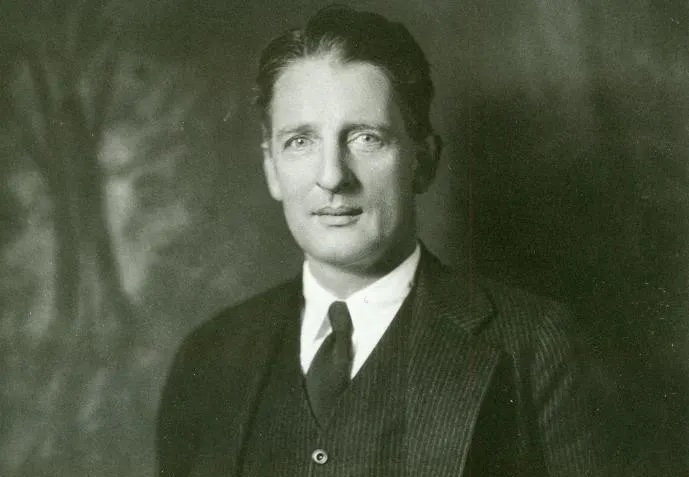“The Novel Is a Wonder”:
Max Perkins
Special to the Newsletter
by Michael F. Bishop
Max Perkins was a literary editor of enduring fame and influence. He is best known for his work at Charles Scribner’s Sons, where he honed the careers of literary giants F. Scott Fitzgerald, Ernest Hemingway, and Thomas Wolfe. His genius lay not just in polishing manuscripts, but in nurturing writers, guiding their creative processes, and often acting as a confidant, financial supporter, and mediator. He once wrote, “The job of editor in a publishing house is the dullest, hardest, most exciting, exasperating and rewarding of perhaps any job in the world.”

Maxwell Evarts Perkins was born on September 20, 1884, in New York City. He grew up in affluent surroundings, with New England roots, his mother an heiress, and his father a lawyer. He graduated from Harvard in 1907 with a degree in economics, but his passion for literature was evident early on. After a brief stint as a reporter for The New York Times, Perkins joined Scribner’s in 1910 as an advertising manager. Scribner’s published Edith Wharton, Henry James. Perkins, and Ernest Hemingway, but he perceived a need to modernize its list by championing new voices that captured the spirit of a changing America.
In 1914, Perkins moved to the editorial department. His first major discovery was F. Scott Fitzgerald, whose debut novel, This Side of Paradise (1920), was initially rejected by other editors. Perkins saw promise in the young writer’s lyrical style and took a risk, pushing for its publication. The novel’s success launched Fitzgerald’s career and established Perkins as an editor with an eye for talent. Their relationship deepened with the crafting of The Great Gatsby. Perkins’ editorial suggestions—such as clarifying Gatsby’s character and tightening the narrative—helped shape the novel into a masterpiece. Perkins’ correspondence with Fitzgerald reveals a delicate balance: he offered constructive criticism while preserving the author’s voice, a hallmark of his approach. And he revered Fitzgerald, saying of Gatsby, “I think the novel is a wonder….it has vitality to an extraordinary degree, and glamor, and a great deal of underlying thought of unusual quality…And as for the sheer writing, it’s astonishing.”
Perkins’ work with Ernest Hemingway further solidified their work. In 1925, Fitzgerald recommended Hemingway to Perkins, who promptly signed him. Hemingway’s The Sun Also Rises and A Farewell to Arms benefited from Perkins’ editorial restraint. Respecting Hemingway’s terse, muscular prose, Perkins made minimal changes, focusing instead on structural clarity and pacing. Their relationship was less emotionally intense than Perkins’ bond with Fitzgerald, but it was marked by mutual respect. Perkins also navigated Hemingway’s volatile personality, including his feuds with other writers, with diplomatic skill.
Perhaps Perkins’ most challenging relationship was with Thomas Wolfe. Wolfe’s sprawling, autobiographical manuscripts were daunting, often arriving in chaotic, voluminous drafts. For Look Homeward Angel, Perkins spent months cutting and reorganizing the text, reducing it by thousands of words to create a coherent narrative. Wolfe, a tempestuous figure, who revered and resented Perkins’ interventions, called him “the mother of my books.” Their collaboration on Of Time and the River was even more contentious, with Perkins shaping the manuscript into a publishable form while Wolfe resisted cuts. Despite their eventual estrangement, Perkins’ faith in Wolfe’s genius produced two landmark novels that might otherwise have remained unwieldy drafts.
Perkins’ editorial philosophy was rooted in empathy and intuition. He believed in fostering a writer’s vision rather than imposing his own. His letters, often warm and encouraging, show him as a mentor who bolstered fragile egos. He lent money to Fitzgerald during financial struggles, counseled Hemingway through personal crises, and spent countless hours wrestling with Wolfe’s manuscripts. Perkins also had a knack for spotting talent in unlikely places. He also championed lesser-known writers like Marjorie Kinnan Rawlings, whose The Yearling won a Pulitzer Prize, and James Jones, who’s From Here to Eternity was published after Perkins’ death. Perkins once observed, “You can’t know a book until you come to the end of it, and then all the rest must be modified to fit that.”
He was not just an editorial genius but also a cultural force. He united the gap between the staid literary establishment and the modernist wave, helping American literature find its voice in the post-World War I era. His office at Scribner’s became a hub for writers, a place where ideas were exchanged, and manuscripts took shape. Yet Perkins remained self-effacing, shunning the spotlight and letting his authors take center stage. He avoided literary circles, preferring a quiet family life with his wife, Louise Saunders, and their five daughters.
Perkins died on June 17, 1947, at age 62, leaving a legacy that reshaped publishing. His methods—collaborative, patient, and deeply personal—set a standard for editors. A. Scott Berg’s biography, Max Perkins: Editor of Genius, portrayed him as a quiet hero of letters. The book inspired the 2016 film, Genius, which starred Colin Firth, Jude Law, and which dramatized his relationship with Wolfe.
His work reminds us that even the greatest writers need invisible help. His ability to nurture talent, even when it came with personal and professional challenges, made him indispensable to his authors and to American literary history.
Michael F. Bishop, a writer and historian, is the former executive director of the International Churchill Society and the Abraham Lincoln Bicentennial Commission.




